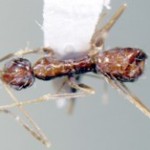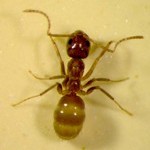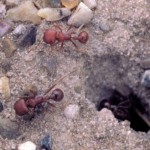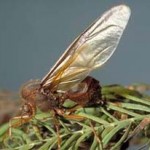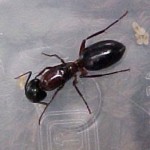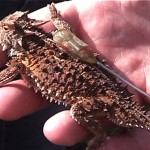- A crazy ant
- Rasberry crazy ant
- Red harvester ants
- Texas leafcutting ant, Atta texana (Buckley), winged male reproductive. Photo by Bart Drees.
- Solenopsis geminata, the tropical fire ant (left). S. invicta, the red imported fire ant (right half).
- Carpenter ant
Collectively, ants (Formicidae: Hymenoptera) are considered to be beneficial in our environment. As a group, they till more earth than earthworms, thereby reducing compaction. Many, like imported fire ants, are predators (and omnivores) and actually reduce population levels of other insect and arthropod pests like ticks, chiggers, caterpillars and beetles. Some ants species, however, are considered pests because of their local abundance, and ability to bite and sting. Few ants cause damage to plants in the landscape. A number of species are are pests in and around the home.
Several exotic invasive pest ant species, such as red imported fire ants and Rasberry crazy ants, are causing serious problems in the landscape. If you have ant samples that need to be identified, download this Ant Sample Submission Form.
Crazy Ants
Although Texas has several species of crazy ants, a new exotic invasive pest ant species was found around Houston (Harris County), Texas in 2002, and has begun to spread with human assistance. The ant has yet to be identified to species and is commonly referred to as the Rasberry crazy ant, Nylanderia sp. nr. pubens (LaPolla, et al).
See also Urban Entomology, Crazy Ants
Texas Leaf-cutting Ants
The Texas leaf-cutting ant, Atta texana (Buckley), has several common names including the town ant, cut ant, parasol ant, fungus ant and night ant. Texas leaf-cutting ants can be extremely destructive to landscape plants, gardens and some agricultural crops in Texas. These ants ants produce numerous hills or “towns” around their colony sites. Foraging worker ants harvest vegetation on which to grow a fungus and then feed on the fungus. The leaf-cutting ant is not very common, but colonies can be a problem in turfgrass areas. Although vegetation can be protected by repeated applications of contact insecticides, eliminating the colony is the only way to prevent recurring damage. There are few methods of safely eliminating colonies.
See also
- Insects in the City, Texas leaf-cutting ant management
- Important update on Texas Leaf-cutting ant control in agricultural use sites
- 24(c) label for Amdro Ant Block
- Video of treating Texas leaf-cutting ant colonies with Amdro Ant Block
Red Harvester Ants
The red harvester ant produces denuded areas of coarse soil particles around the central openings to its colonies. Harvester ants can bite and sting and can be dangerous to sensitive individuals. These ants also serve as food for the even rarer horned lizard.
See also Extension publication E-402, Red Harvester Ants
Carpenter Ants
Carpenter ants are social insects that make their colonies primarily in wood. They hollow out wood to build their nests, making their galleries and chamber velvety smooth, as if a carpenter had sanded the surfaces. Tunneling in wood and foraging for food lead to their status as pests in and around the home.
Although carpenter ants nest in tree trunks and limbs, they are not considered to be pests of tree health because they only nest in often decaying heartwood or other cracks and crevices like tree holes. They do not use wood as food like termites, but use wood as a nesting location. However, excavation of nesting galleries may contribute to structural damage of trunks and limbs.
See also
Other Ant Species
Several other species of ants occasionally cause concern. Many of these species are native to the state and are not considered to be major pests. Pyramid ants are grayish black and produce small mounds featuring an edge or rim around the top. These ants are not harmful. Another native species, the little black ant, is common and its colonies are seldom encountered. This species is known to prey upon the queens of the red imported fire ant.
Household Ants
In nature, ants are generally considered to be beneficial insects. But when they invade a home, ants can be a nuisance. Some ant species have been shown to spread disease organisms from infected to non-infected individuals. To manage an ant infestation in the home, you must first identify the species. The next step is to learn about the biology of that species and determine where the colony might be nesting. Some species commonly nest indoors, while others nest outside and enter a home just to look for food.
See also: Managing Household Ants

